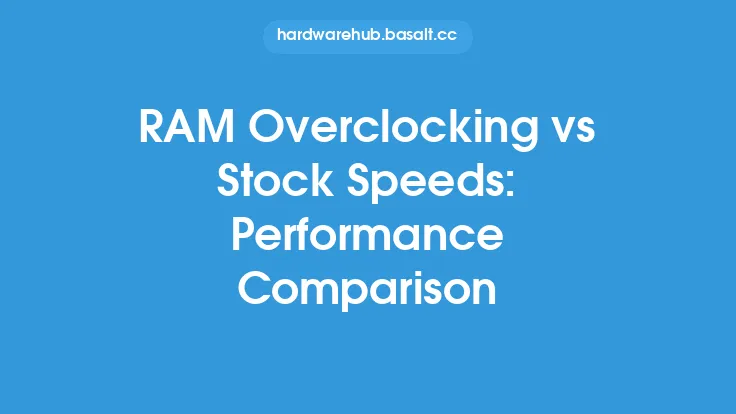When it comes to computer memory, two key factors come into play: RAM capacity and performance. While these terms are often used interchangeably, they refer to distinct aspects of a computer's memory subsystem. In this article, we'll delve into the differences between RAM capacity and performance, exploring the technical aspects of each and how they impact overall system functionality.
Introduction to RAM Capacity
RAM capacity refers to the total amount of memory available in a computer, measured in units such as gigabytes (GB) or terabytes (TB). It represents the maximum amount of data that can be stored in the computer's memory at any given time. The capacity of RAM is a critical factor in determining how many applications can run simultaneously, as well as the overall responsiveness of the system. A higher RAM capacity allows for more applications to be open at the same time, reducing the need for the system to rely on slower storage devices like hard drives.
Understanding RAM Performance
RAM performance, on the other hand, refers to the speed at which data can be read from and written to the memory. It is typically measured in terms of bandwidth, latency, and clock speed. Bandwidth represents the amount of data that can be transferred between the memory and the system's processor per unit of time, usually expressed in gigabytes per second (GB/s). Latency refers to the time it takes for the system to access data stored in the memory, with lower latency indicating faster access times. Clock speed, measured in megahertz (MHz) or gigahertz (GHz), determines how many operations the memory can perform per second.
Technical Differences
From a technical standpoint, RAM capacity and performance are influenced by different factors. Capacity is primarily determined by the number and density of memory chips on the RAM module, as well as the type of memory technology used (e.g., DDR4, DDR5). Performance, however, is affected by the memory's interface speed, timings (such as CAS latency), and the quality of the memory controller. For instance, a RAM module with a higher clock speed and tighter timings can provide better performance than one with a lower clock speed, even if they have the same capacity.
Impact on System Functionality
The interplay between RAM capacity and performance has a significant impact on system functionality. A system with ample RAM capacity but poor performance may struggle to handle demanding applications, leading to slowdowns and decreased responsiveness. Conversely, a system with high-performance RAM but limited capacity may need to frequently access slower storage devices, also resulting in decreased performance. Ideally, a balance between capacity and performance is necessary to ensure smooth system operation, especially in applications that require both large amounts of memory and fast data access, such as video editing, 3D modeling, and gaming.
Upgrading RAM for Better Performance
When considering an upgrade to improve system performance, it's essential to evaluate both the capacity and performance aspects of the RAM. Simply adding more RAM without considering the performance characteristics may not yield the desired improvements. For example, upgrading from 8GB of DDR4 RAM to 16GB of DDR4 RAM can significantly improve multitasking capabilities, but switching from DDR4 to DDR5, which offers higher speeds and lower latencies, can provide a more substantial performance boost for applications that rely heavily on memory bandwidth.
Conclusion
In conclusion, while RAM capacity and performance are related, they are distinct factors that influence the overall functionality and responsiveness of a computer system. Understanding the differences between these two aspects of RAM can help users make informed decisions when upgrading or configuring their systems, ensuring they achieve the right balance between capacity and performance for their specific needs. Whether for general use, gaming, or professional applications, optimizing both the capacity and performance of RAM can significantly enhance the computing experience, making it faster, more efficient, and more enjoyable.





